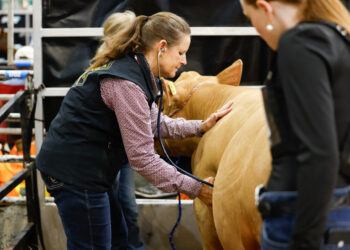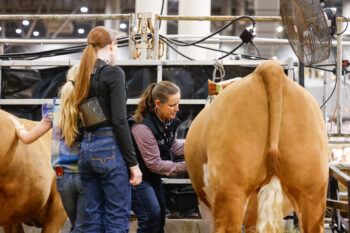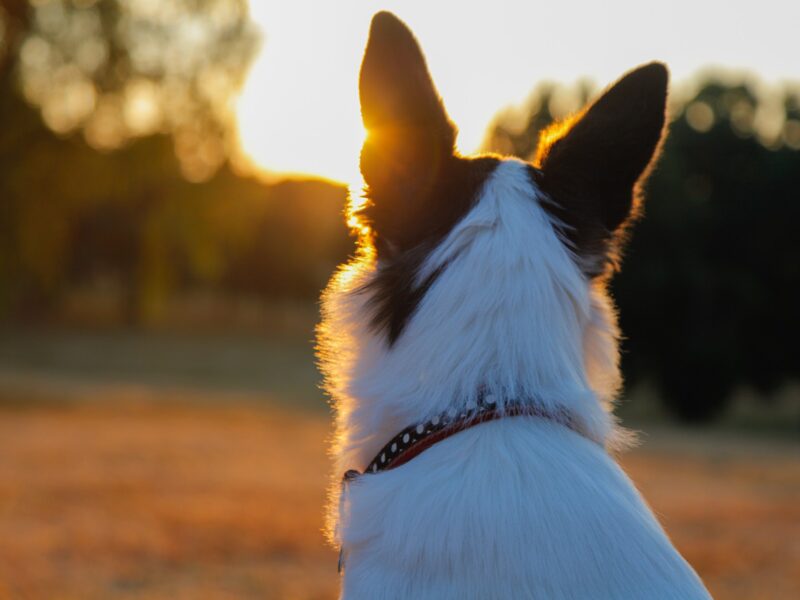Aggie Serves As Houston Livestock Show And Rodeo Veterinarian For 21st Year

On most days, you’ll find Dr. Leslie Easterwood ’90, an associate clinical professor of equine community practice at the Texas A&M School of Veterinary Medicine & Biomedical Sciences (VMBS), in Texas A&M’s Large Animal Teaching Hospital, where her typical week includes caring for patients, teaching future Aggie veterinarians and educating students on how to incorporate service into their veterinary careers.
From the end of February to mid-March, however, you’ll find Easterwood practicing what she teaches while serving as one of two official veterinarians at the Houston Livestock Show and Rodeo (HLSR), where she leads a team of volunteers in caring for the 18,000 livestock animals that visit the HLSR during the almost three-week event.
“The HLSR helped me so much that I’ll always owe it to Houston to go down there,” Easterwood said. “I enjoy just about every minute of it. My biggest goal when I’m serving in this role is giving back to an organization that does so much good.”
Working the HLSR
Easterwood and Dr. Gregg Knape ‘76, another Aggie veterinarian who serves as an official HLSR veterinarian, are among the more than 6,000 Aggies who have received academic funding support from the HLSR while attending Texas A&M University.
“We both grew up in Alvin, which is just 30 minutes from the Astrodome, so for us, going to the HLSR is like going home,” explained Easterwood, adding that at least one of her Aggie Doctor of Veterinary Medicine (DVM) students also is an HLSR scholarship recipient each year.
Easterwood and Knape have shared the official HLSR veterinarian duties since 2003 and continue to lead a committee of volunteers comprising veterinarians, DVM students and pre-veterinary undergraduates.
“I do three things at the show, with the overall goal of ensuring that the animals’ welfare and well-being are cared for,” Easterwood said. “I care for livestock that develop health issues, either while traveling to or spending time on property; I address animal health regulation needs as they arise; and I administer the HLSR drug-testing program, which requires all show stock to be tested before competing, with the help of our committee volunteers and students.”
Easterwood said her role changes as different types of livestock are at the HLSR on any particular day, but you’d be hard-pressed to find a day where she doesn’t walk the livestock barns to check on animals, visit animals in the birthing center, care for horses in the equine arena, or check on her patients at the petting zoo.

“My relationships with my patients and their owners have always been very personal for me, so I want to check in regularly and make sure everyone is OK,” Easterwood said. “While doing so, I get to see people whom I only see once a year, including elementary- to high-school-aged students who ask questions and occasionally express their interest in becoming a veterinarian.
“I’ve been doing this for so long that I’ve gotten to know a lot of folks, and that’s really cool, too,” she said. “Now, there are parents who were exhibitors when I started, and they’re bringing their kids to the show, or they’ve become an ag teacher and they’re bringing students to the HLSR. I’ve gotten to watch them grow up, and now I get to work with their kids.”
At night, while Knape takes the lead in serving as the veterinarian for the rodeo performance, Easterwood is on call to care for any rodeo stock that may need veterinary attention outside of the arena and she continues to care for livestock that require medical attention. For example, in 2009, she bottle fed a piglet whose mother was unable to produce milk throughout the night.
“It’s really important for us to be down there, and it means a lot to me to be able to represent Texas A&M and the VMBS while I’m there,” Easterwood said.
An HLSR & Aggie Tradition
The HLSR has a long-standing tradition of supporting young Texans in their collegiate careers, including the tradition of supporting Aggies, which dates back to 1957 when Ben Dickerson ‘61 became the first HLSR scholarship recipient.
Thanks to the continued generosity of the HLSR and those who support it, the organization has now awarded more than $85 million in scholarships to Texas A&M students, with about 750 Aggie students benefiting from the HLSR’s generosity each year.
Easterwood said she’s proud to be among the 34,000 HLSR volunteers who help make the scholastic support the organization provides students possible.
“It’s a good time for me to get away, do something completely selfless, recharge, and see all the people whom I only see once a year that are also there for the same reason,” she said. “All of the volunteers — from the ag teachers to the superintendents, to the HLSR staff, to the parking lot traffic directors — we’re all there for the same reason, and that’s to raise that scholarship money and support the next generation.”
Media contact: Jennifer Gauntt, jgauntt@cvm.tamu.edu, 979-862-4216





